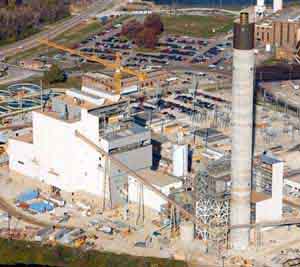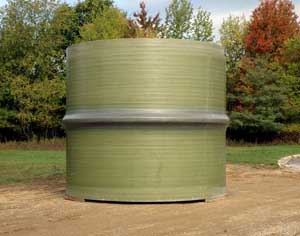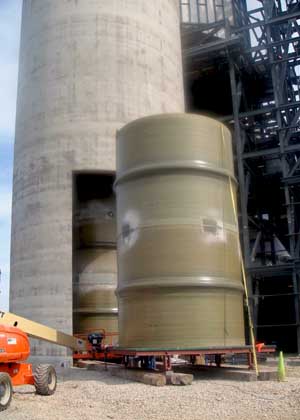Designing New Composite Stack Liners
Dallman Unit 4 is under construction (Figure 1) by the City Water, Light and Power (CWLP) utility of the City of Springfield, Ill. The 200-MW Unit 4 will fire pulverized coal when it enters commercial service in 2010 and will allow an older 76-MW coal-fired facility to be retired. The new, cleaner generating station is expected to cost approximately 20% less to operate per megawatt-hour than the most efficient of the three existing Dallman units.

1. Dallman Unit 4 under construction in Springfield, Ill. Courtesy: City Water, Light & Power of the City of Springfield, Ill. Photograph taken by Terry Farmer
The plant was designed by the engineering firm of Black & Veatch to be one of the most efficient and environmentally friendly coal power units in the U.S. The new plant and pollution control improvements at existing Dallman units will enable CWLP to reduce carbon dioxide emissions to below 1990 levels.
CWLP also will be on target to comply with the State of Illinois proposal to reduce mercury emissions by 90%. Treated exhaust gases will be released to the atmosphere by a 440-foot-tall concrete chimney with a fiber-reinforced polymer (FRP) composite liner. This composite was specified for the liner because it is more cost-effective than metals for resisting the hot, corrosive environment of the exhaust process.
A Polymer That Can Take the Heat
Tri-Clor Inc., Hasting, Mich., used state-of-the-art filament winding to manufacture the liner in 27 sections that were shipped to the construction site. Each section, referred to as a “can,” was 13.5 feet tall by 15 feet in diameter. The sections were aligned to within 0.25-inch tolerance during field joining. After surface preparation, the sections were bonded together with interior and exterior laminates of 0.375-inch-thick fiberglass/resin composite. A top coat was applied after cure.
The high-performance resin for the liner was Vipel K022-AC fire-retardant bisphenol, an epoxy vinyl ester from North American corrosion resin vendor AOC. AOC also provided valuable technical support, said Seumas St. George, lead engineer for Kiewit Black & Veatch (KVB), the joint-venture general contractor for plant construction.
“The stack liner was highly successful because of the way AOC and Tri-Clor worked together,” said St. George. “AOC technical experts are very knowledgeable and helped Tri-Clor optimize the manufacturing process for liner sections.
“The cooperation between fabricator and resin supplier and Tri-Clor’s workmanship were important elements in keeping the chimney project precisely on schedule,” added St. George. He said the quality of the liner cans was monitored by independent composite quality control consultant Juan L. Bustillos, PE, president of Bustillos & Associates LLC of Lake Jackson, Texas.
Modern Fabrication Process
Tri-Clor manufactured the 27 cans in its modern, arch-shaped facility in Hastings. Despite their impressive sizes, the building and equipment are designed to be portable for projects that would benefit from on-site composite cylinder fabrication.
Tri-Clor’s cylinder-shaping mandrel is 14 feet in diameter, the standard dimension for many filament-wound composite applications such as tanks and scrubber shells. To achieve the 15-foot-diameter requirement for the stack liner cans, Tri-Clor added a layer of urethane foam, which was then encapsulated between the initial 14-foot cylinder and an outer layer of additional filament-wound composite.
During filament winding, nonwoven fiber veils and glass fibers are impregnated with resin and then applied to the rotating mandrel. For the power plant stack liner, the resin was the previously mentioned Vipel K022-AC, engineered by AOC chemists to offer a combination of process and performance benefits (Figure 2).

2. Vipel K022-AC vinyl ester provides a user-friendly processing window when fabricating stack liners.
“The production technicians really like the versatile workability of the resin,” commented Tim Schoessel, Tri-Clor’s president. “The material has good wetting characteristics and works within a wide processing window that is very accommodating.” Schoessel says that “Vipel can take the heat.”
Vipel K022-AC was also specified for its extraordinary performance properties. The resin resists the hot, moist exhaust smoke that will enter the stack with trace amounts of acidic gases. Such an environment would corrode the concrete chimney surface (Figure 3).

3. The 13.5-foot-tall by 15-foot-diameter liner cans were shipped from Tri-Clor’s Hastings, Mich., facility.
For strength, the resin’s high mechanical properties combine with fiber-reinforcing properties to withstand the static load of the 440-foot-high, assembled structure (Figure 4). For fire retardance, the resin meets ASTM E84 Class I flame spread and smoke requirements.

4. The composite cans were installed in the chimney to form a heat- and corrosion-resistant liner.
The standard operating temperature within the chimney is expected to be in the 130F to 180F range. A published technical study by AOC Technical Corrosion Specialist Scott Lane demonstrated the liner’s excellent resistance to temperature surges. Lane’s analysis concluded that laminates made with brominated vinyl esters such as Vipel K022-AC can meet structural and corrosion-resistant specifications after short-term exposure to temperatures as high as 500F. Lane’s technical paper can be downloaded here (PDF).
—Ben Bogner ([email protected]) is market development specialist for AOC.